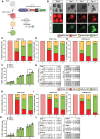Development of an intraventricular adeno-associated virus-based labeling strategy for glioblastoma cells nested in the subventricular zone
- PMID: 39445338
- PMCID: PMC11497599
- DOI: 10.1093/noajnl/vdae161
Development of an intraventricular adeno-associated virus-based labeling strategy for glioblastoma cells nested in the subventricular zone
Abstract
Background: Glioblastoma (GBM) is a dreadful brain tumor, with a particular relationship to the adult subventricular zone (SVZ) that has been described as relevant to disease initiation, progression, and recurrence.
Methods: We propose a novel strategy for the detection and tracking of xenografted GBM cells that are located in the SVZ, based on an intracerebroventricular (icv) recombinant adeno-associated virus (AAV)-mediated color conversion method. We used different patient-derived GBM stem-like cells (GSCs), which we transduced first with a retroviral vector (LRLG) that included a lox-dsRed-STOP-lox cassette, upstream of the eGFP gene, then with rAAVs expressing the Cre-recombinase. Red and green fluorescence is analyzed in vitro and in vivo using flow cytometry and fluorescence microscopy.
Results: After comparing the efficiency of diverse rAAV serotypes, we confirmed that the in vitro transduction of GSC-LRLG with rAAV-Cre induced a switch from red to green fluorescence. In parallel, we verified that rAAV transduction was confined to the walls of the lateral ventricles. We, therefore, applied this conversion approach in 2 patient-derived orthotopic GSC xenograft models and showed that the icv injection of an rAAV-DJ-Cre after GSC-LRLG tumor implantation triggered the conversion of red GSCs to green, in the periventricular region. Green GSCs were also found at distant places, including the migratory tract and the tumor core.
Conclusions: This study not only sheds light on the putative outcome of SVZ-nested GBM cells but also shows that icv injection of rAAV vectors allows to transduce and potentially modulate gene expression in hard-to-reach GBM cells of the periventricular area.
Keywords: Glioblastoma; SVZ-nested GBM cells; adeno-associated virus; intracerebroventricular; subventricular zone.
© The Author(s) 2024. Published by Oxford University Press, the Society for Neuro-Oncology and the European Association of Neuro-Oncology.
Conflict of interest statement
None declared.
Figures






References
-
- Stupp R, Mason WP, van den Bent MJ, et al.; European Organisation for Research and Treatment of Cancer Brain Tumor and Radiotherapy Groups. Radiotherapy plus concomitant and adjuvant temozolomide for glioblastoma. N Engl J Med. 2005;352(10):987–996. - PubMed
-
- Rapp M, Baernreuther J, Turowski B, et al.. Recurrence pattern analysis of primary glioblastoma. World Neurosurg. 2017;103:733–740. - PubMed
-
- Ignatova TN, Kukekov VG, Laywell ED, et al.. Human cortical glial tumors contain neural stem-like cells expressing astroglial and neuronal markers in vitro. Glia. 2002;39(3):193–206. - PubMed
-
- Sanai N, Tramontin AD, Quinones-Hinojosa A, et al.. Unique astrocyte ribbon in adult human brain contains neural stem cells but lacks chain migration. Nature. 2004;427(6976):740–744. - PubMed
LinkOut - more resources
Full Text Sources
Research Materials
